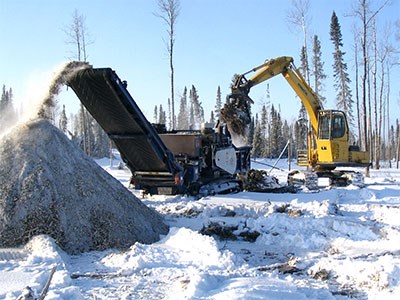Canada's forest industry is shaking itself free of a decade-long funk that resulted in waves of mill closures and layoffs.
With industry analysts forecasting North American lumber prices to skyrocket this year and predicting the entire sector is on the verge of a global “super cycle,” Canadian producers have a pressing immediate and long-term need to replenish its workforce.
Through the Ottawa-based Forest Products Association of Canada (FPAC), the industry is trying to attach a fresh, green face to an historic, but battered, sector.
After the bloodletting of the 2000s caused by lumber tariffs, a high dollar and the crash of the U.S. housing market, the perception of Canada's forestry sector is not the greatest, particularly among young people and job seekers looking for careers with some longevity.
A Canadian forest industry labour force study is shooting for a goal of recruiting 60,000 workers by the year 2020.
David Lindsay, the association's president and CEO, said there's a new story to be told of an industry that's making strides in becoming more globally competitive, has made inroads into Asia, has become more innovative with new bio-products, and has among the best environmental track records anywhere.
“The industry has gone through some difficulties, but we see a transformation into new businesses and new opportunities that are starting to take hold,” said Lindsay, a former Ontario deputy minister of Natural Resources and Northern Development and Mines.
“And we're going to need all kinds of new employees to help build that new forest sector.”
An association labour study – the Vision 2020 paper – released last May contains a lengthy list of in-demand occupations, that number in the thousands, that Canadian forest products companies are now recruiting.
There are pressing needs for sawmill and paper machine operators, front line-supervisors, silviculture workers, technicians, skidder operators, log labourers, truck drivers, material handlers, millwrights, electricians, steam/power engineers and heavy equipment operators.
As part of an attraction and retention strategy, the association wants to showcase career opportunities that target young people, Aboriginals, immigrants and especially women for both the traditional jobs and the next-generation positions.
“Women have traditionally not looked to the forest sector as an employment opportunity, but it's very similar to mining,” said Lindsay. “It's become quite high-tech and requires all kinds of skill sets, not just brawn.
“We also need people who understand computer technology and sophisticated practices of the chemistry, can run the mills, and everything from truck drivers right through to scientists working in labs.”
In February, the association is launching a new online presence (www.greenestworkforce.ca) and is employing social media to provide information on job profiles, video testimonials and links to FPAC member companies.
One recruiting tool is a contest with a $5,000 prize and iPad giveaways to encourage young people to submit a two-minute video audition to compete for eight summer internships with FPAC's member companies.
Lindsay said the economic downturns that chased away many skilled workers can't always be avoided in any industry sector, but diversification can smooth out the cycles.
“The plan is to diversify our products and our markets so that we were not just solely dependent on U.S. housing starts or the thickness of the New York Times. The more products you're offering to your customers, the more you're diversifying your portfolio and insulating yourself from the vagaries of the cycle.”
The Asian countries are fast-growing new markets for Canadian forest products, particularly sales of lumber and cardboard into China and pulp into India.
“It's taken seven or eight years to establish ourselves, but it's starting to take off,” said Lindsay. “We're broadening our markets and we're getting into new products.”
Whereas pulp was traditionally earmarked for newsprint, tissue and toilet paper production, companies like India's Birla Group have made investments in Ontario and New Brunswick to buy shuttered pulp mills and install pulp dissolving machinery to convert the wood fibre byproduct into rayon for clothing.
Lindsay said pulp mills can be viewed as sophisticated refineries producing a stream of byproducts that are finding their way into cosmetics and car parts.
Auto parts makers like Magna are experimenting to lighten the weight of cars by substituting metal and plastic parts, like door panels and bumpers, with forest fibre.
“Anything you can make out of the complex carbon molecules of oil and petroleum, you should in theory make out of the molecules of a tree,” said Lindsay.
To get young people interested, FPAC's campaign is geared to those that are environmentally conscious and outdoor-oriented by playing up the industry's sustainability side in showcasing the certification process of replanting and rejuvenating forests.
Lindsay said the industry has to spotlight its environmental record, which in itself, is a selling point for bulk purchasers of forest products.
“Canadian forestry companies have a very strong record in contrast and comparison to some of their international competitors. A green workforce and green product is not just a marketing slogan, but it actually has business benefits (to) encourage customers to look at Canada's forest products as among the best in the world.
To compete against tropical countries that can grow wood faster, Lindsay said Canadian industry must continue to invest time and money in higher value-added products.”
While Canadian banks have been averse to invest in forestry, Lindsay said the industry's transformation wouldn't have happened without the federal Pulp and Paper Green Transformation Program and various provincial funding for mill upgrades, new technology and green energy conversions.
“The government has realized that during tough economic times, just giving a subsidy to a company is not the best way to make them sustainable, so they've created these programs to help them invest in the future and invest in new technologies and equipment.”




